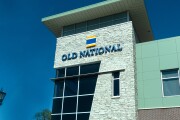
Management at Old National Bank in Evansville, Indiana, highlighted the efforts of its staff after the company was devastated by a mass shooting at a Louisville, Kentucky, branch earlier this year.
"I want to thank countless individuals and organizations who have cared for and supported our family during this challenging time," Jim Ryan, CEO of Old National, said during the bank's second-quarter earnings call on Tuesday. "I also want to acknowledge and thank our team members for their resiliency and their commitment to supporting one another."
On the morning of April 10, before the bank's opening, employee Connor Sturgeon
Sturgeon, a 23-year-old who worked as a syndication associate and portfolio banker according to his LinkedIn profile, was then shot and killed by a policeman.
Old National relocated their downtown Louisville location from Preston Pointe to the Mercer Building on West Market Street "out of respect for the Old National team members lost and impacted," according to Ryan in a press release in May.
"More than three months later, our ONB family continues to do our best to love, care for and support one another," Ryan said during the earnings call on Tuesday.
In addition to acknowledging the April tragedy, the $48 billion-asset bank reported healthy second-quarter earnings. Old National posted second-quarter net income of $155 million, up 36% from the same period a year earlier.
Loans and deposit portfolios, which management described as "granular and relationship-driven," grew by 2% and 4% respectively from the first quarter. The bank sold $300 million in "non-relationship" commercial-and-industrial loans at par. The move was meant to provide liquidity and allow the bank to focus on "clients with full-banking relationships," CFO Brendon Falconer said.
At the end of the second quarter, the commercial loan pipeline totaled roughly $3 billion, down from $5.4 billion in the first quarter. Ryan attributed that decline to an internal effort of "rationing" the company's balance sheet.
Falconer also noted that despite worries about deteriorating consumer credit quality, its portfolio has remained "stable." Net charge-offs totaled roughly $10 million, down 38% from the first quarter but up significantly from the $1.8 million recorded in the same period a year earlier. However, net charge-offs for this quarter fell to 6 basis points of average loans, from 13 basis points, once certain loans that had an allowance established at the time of acquisition were excluded.
"We remain watchful and consistent with other banks on potential pockets of softness," added Ryan.
The loan-to-deposit ratio stood at 90% at the end of the second quarter.
"We improved our earning asset mix with cash flows for an investment portfolio reinvested in loans, while our funding mix improved through higher deposit balances and lower borrowings," Falconer said.
Over this summer, the bank has fortified its commercial banking capabilities in certain regional markets. In June, the bank entered the metro Detroit area with a new commercial banking office and team, led by Rick Hampson who joined the bank in January. Hampson has almost 30 years of commercial banking experience in large corporate syndicated banking and middle market banking. Old National's Michigan footprint had already included a presence in Ann Arbor, Grand Rapids and Kalamazoo.
In July, the bank announced the addition of a commercial banking duo, Clif Tant and Robert Macyauski, to its existing Nashville wealth management team, with the addition of a branch in Brentwood, Tennessee.
"You've got a lot of growth initiatives, but you've really been able to self-fund it and haven't raised the expense guidance, which I think has been a real positive surprise," Terry McAvoy, an analyst from Stephens, told executives during the call.
Noninterest expenses totaled roughly $247 million in the second quarter, down about 11% from the same period a year earlier.
"That's the goal right?" Ryan said in response. "I mean, I think we have continued to … invest in people and any technology needs but at the same time, we [have] to figure out ways to self fund that. And so we want to be incredibly disciplined around what that looks like."






